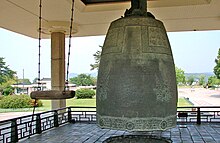Bell of King Seongdeok
| Bell of King Seongdeok | |

National Treasure of Korea No.29: The Bell of King Seongdeok.
|
|
| Korean name | |
|---|---|
| Hangul | 성덕대왕신종, 에밀레종 |
| Hanja | 聖德大王神鍾, 에밀레鍾 |
| Revised Romanization | Seongdeok daewang sinjong, Emile jong |
| McCune–Reischauer | Sŏngdŏk taewang sinjong, Emile chong |
Coordinates: 35°49′46.47″N 129°13′40.54″E / 35.8295750°N 129.2279278°E
The Bell of King Seongdeok is a massive bronze bell, the largest extant bell in Korea. The full Korean name means "Sacred (or Divine) Bell of King Seongdeok the Great." It was also known as the Emile Bell, after a legend about its casting, and as the Bell of Bongdeoksa Temple, where it was first housed.
The bell was commissioned by King Gyeongdeok to honor his father, King Seongdeok. However, King Gyeongdeok never lived to see the casting of the bell, as he died in 765 A.D. The bell was finally cast in 771 A.D., during the reign of Gyeongdeok's son, King Hyegong.
Now stored in the National Museum of Gyeongju, the bell was designated as the 29th national treasure of Korea on December 12, 1962. It measures 3.33 meters high, 2.27 meters in diameter, and 11 to 25 centimeters in wall thickness. The Gyeongju National Museum weighed it in 1997, and found that its weight was 18.9 tons.
When rung, it is said to have been heard from 40 miles away on a clear day..
The bell is considered a masterpiece of Unified Silla art. It is unique among Korean bronze bells because of the presence of a small hollow tube near the hook. The whole structure, including its decorative elements, produces a wide range of sound frequencies; the tube absorbes high frequency waves, contributing to a distinctive beat.
...
Wikipedia
